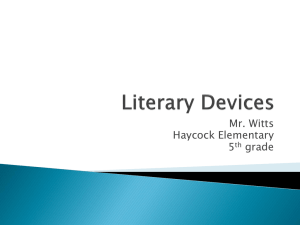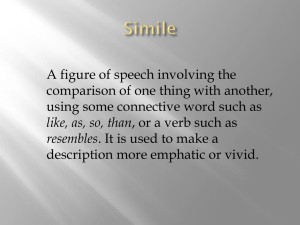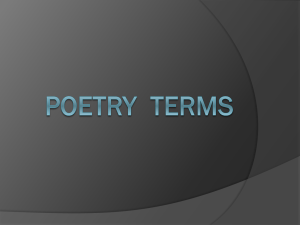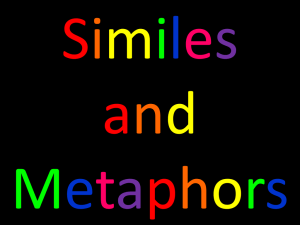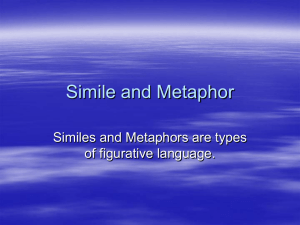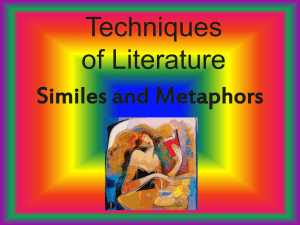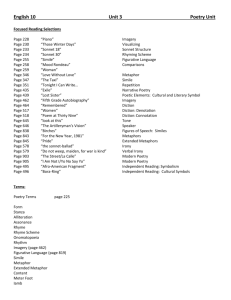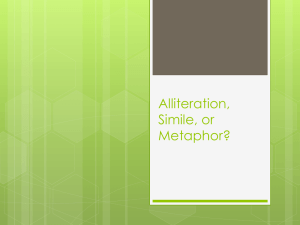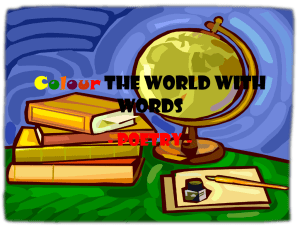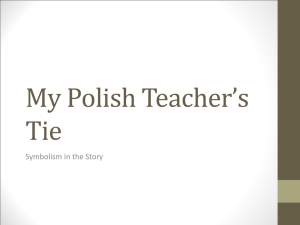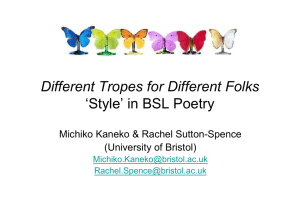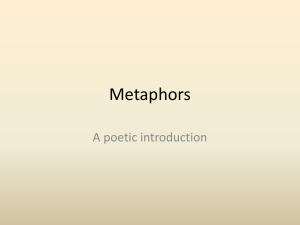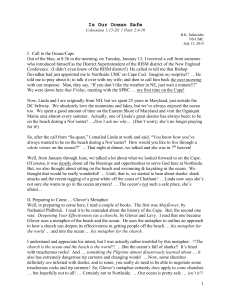Poetic devices
advertisement
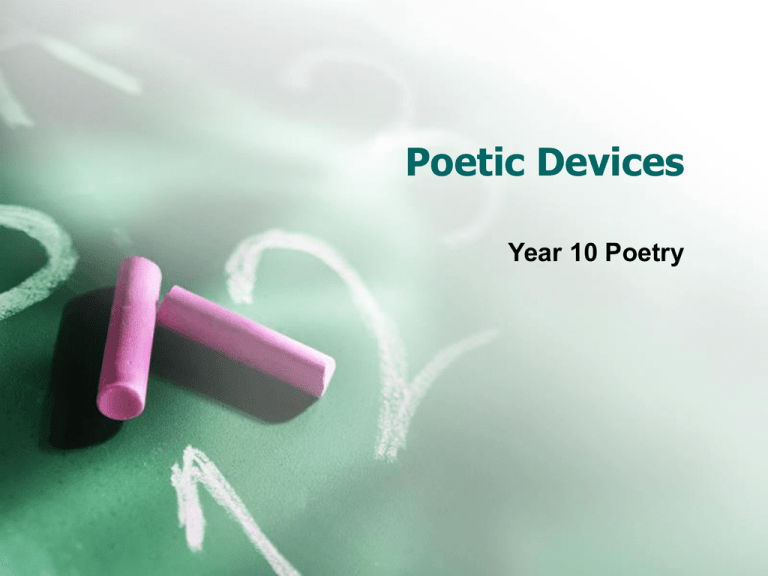
Poetic Devices Year 10 Poetry Structuring a response Remember to use: S tate the technique Give an E xample from the text x E plain the effect of the technique. How does it achieve the composer’s purpose Structuring a response cont. The poet/(Poet’s surname) uses name of technique in give example. This shows/ conveys/ emphasizes/ suggests that/ implies/ promotes/ illustrates/ highlights/ draws attention to explain image/message/emotion/or sense the poet is appealing to For example: In “Beach Burial”, Slessor uses alliteration in the title “Beach Burial” to draw attention to the “b” sound which echos the sound of guns going off. In doing this, Slessor conveys that there has been a gun battle at a beach which has resulted in death. Poetry • Remember that the purpose of poetry is to create imagery through the use of language devices. • When you analyse poetry, you must explain how these techniques are used to convey a particular image. TECHNIQUES IMAGERY TECHNIQUES SOUND TECHNIQUES • Metaphor • Alliteration • Simile • Assonance • Personification • Onomatopeia • Symbolism • Rhyme • Rhythm OTHER • Tone METAPHOR • Comparison that asks us to picture one as if it is another • Requires an explicit comparison to be made FOR EXAMPLE The moon’s a balloon. The moon was a ghostly galleon tossed upon cloudy seas. That old clean bone, the moon. Metaphor The beach is a quarter of golden fruit, a soft ripe melon sliced to a half-moon curve, having a thick green rind of jungle growth; and the sea devours it with its sharp, sharp white teeth By William Hart-Smith Simile Comparison using like, as or than. FOR EXAMPLE “O my Luve’s like a red, red rose That’s newly sprung in June:” From “A red, red rose” by Robert Burns This cold grey winter afternoon The starlings On the television aerial Look like sultanas on a stalk By Lucy Hosegood Simile The cloud tonight is like a white Persian cat – From “Summer full moon” by James Kirkup Personification • A type of metaphor in which non-living (inanimate) things are given human qualities FOR EXAMPLE The wind is angry – he’s been in a rage all night stamping his feet, bellowing and finally breaking out. From “The wind is angry” by Adrienne Brady “Slowly, the fog Hunch-shouldered with a grey face” From “The fog” by F. R. McCreary Symbolism • The use of a concrete object to represent an abstract idea. Your words or phrases can have a double meaning. • Symbolism occurs when an image represents a wider concept. It is subtler than a metaphor (no direct comparison) FOR EXAMPLE “Two roads diverged in a wood, and I – I took the one less travelled by, And that has made all the difference.” From “A road not taken” by Robert Frost Alliteration • The repetition of the same consonant sound. FOR EXAMPLE The fair breeze blew, the white foam flew The furrow followed free; From “The rime of the Ancient Mariner” by Samuel Coleridge Assonance • The repetition of the same vowel sound. FOR EXAMPLE The cloud tonight is like a white Persian cat – From “Summer full moon” by James Kirkup Onomatopeia • Words that echo the sound of the action. FOR EXAMPLE The hail tinkles onto the tin roof a tiny timpani of tintinnabulation Rhyme • When the endings of words or lines sound the same. FOR EXAMPLE I am the daughter of Earth and Water, And the nursling of the Sky; I pass through the pores of the ocean and shores; I change but cannot die. From “The cloud” by Percy Bysshe Shelley When vile men jeer because my skin is brown, This I live down. But when a taunted child comes home in tears, Fierce anger sears From “Colour Bar” by Oodgeroo Noonuccal Rhythm • The pattern of heavy and weak (stressed and un stressed) syllables in a line. FOR EXAMPLE x / x / x / x / The wind and rain and sleet and hail / x / x / x / Lashed the boat and ripped the sail Won’t somebody listen, listen to us please, give us what we ask for, give us what we need. Tone • The mood or emotion of the poem. • Created by language techniques, word choice, sentence length and imagery.

